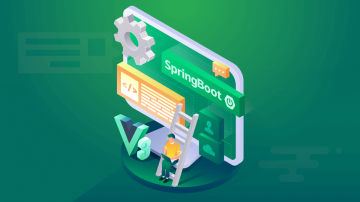Spring Boot微服务实战涵盖了从Spring Boot基础入门到微服务架构设计的全过程,包括快速搭建Spring Boot项目、服务拆分与通信、以及微服务部署与监控等关键环节。文章详细介绍了如何使用Spring Cloud进行服务发现与注册、构建服务网关,并提供了性能优化、安全性增强及测试调试的最佳实践。通过这些内容,开发者可以全面掌握Spring Boot微服务的实现与优化方法。
Spring Boot基础入门 Spring Boot简介Spring Boot 是一个用于简化 Spring 应用配置的框架,其核心目标是简化开发者对 Spring 框架的使用,使开发者能够快速构建独立运行的、生产级别的基于 Spring 的应用。Spring Boot 自带了大量默认配置,开发者可以专注于业务逻辑的实现,而无需过多关注底层配置。
Spring Boot 提供了许多特性,包括:
- 自动配置:根据项目依赖自动配置 Spring,例如添加了 JDBC 依赖,Spring Boot 会自动配置数据库连接。
- 内嵌容器:内置了 Tomcat、Jetty 或 Undertow,允许直接运行 Spring 应用,无需部署到外部容器。
- 无需 XML 配置:大多数情况下,可以无需 XML 配置,使用注解配置。
- 依赖管理:提供了强大的依赖管理功能,简化了 Maven 和 Gradle 项目的依赖配置。
- 命令行运行:可以通过命令行执行应用,非常适合开发、原型创建和脚本任务。
搭建 Spring Boot 项目极为简单,可以通过多种方式创建项目,例如使用 Spring Initializr 网站、IDE 的插件或手动创建。
使用Spring Initializr网站创建项目
- 访问 Spring Initializr。
- 选择项目配置,例如 Maven 项目、Java 版本等。
- 添加项目依赖,例如 Web 依赖、Thymeleaf 模板引擎等。
- 点击 "Generate" 按钮,下载项目压缩包并解压。
使用IDE插件创建项目
如果使用 IntelliJ IDEA 或 Eclipse,可以通过插件直接创建 Spring Boot 项目。
在 IntelliJ IDEA 中:
- 打开 "File" -> "New" -> "Project"。
- 选择 "Spring Initializr",点击 "Next"。
- 选择项目依赖,例如 Web 依赖、Thymeleaf。
- 填写项目信息,例如项目名称、语言等。
- 点击 "Finish",IDE 会自动下载依赖并创建项目。
手动创建项目
如果手动创建项目,需要先创建目录结构,再导入依赖。
mkdir spring-boot-example
cd spring-boot-example
mkdir src/main/java
mkdir src/main/resources
mkdir src/test/java在项目根目录添加 pom.xml 文件,用于 Maven 依赖管理。
<project xmlns="http://maven.apache.org/POM/4.0.0"
xmlns:xsi="http://www.w3.org/2001/XMLSchema-instance"
xsi:schemaLocation="http://maven.apache.org/POM/4.0.0 http://maven.apache.org/xsd/maven-4.0.0.xsd">
<modelVersion>4.0.0</modelVersion>
<groupId>com.example</groupId>
<artifactId>spring-boot-example</artifactId>
<version>1.0.0</version>
<packaging>jar</packaging>
<parent>
<groupId>org.springframework.boot</groupId>
<artifactId>spring-boot-starter-parent</artifactId>
<version>2.5.4</version>
<relativePath/>
</parent>
<dependencies>
<dependency>
<groupId>org.springframework.boot</groupId>
<artifactId>spring-boot-starter-web</artifactId>
</dependency>
</dependencies>
<build>
<plugins>
<plugin>
<groupId>org.springframework.boot</groupId>
<artifactId>spring-boot-maven-plugin</artifactId>
</plugin>
</plugins>
</build>
</project>在 src/main/java 目录下创建主类。
package com.example.demo;
import org.springframework.boot.SpringApplication;
import org.springframework.boot.autoconfigure.SpringBootApplication;
@SpringBootApplication
public class DemoApplication {
public static void main(String[] args) {
SpringApplication.run(DemoApplication.class, args);
}
}完成以上步骤,一个简单的 Spring Boot 项目就搭建好了。
Maven与Gradle依赖管理Spring Boot 通过 Maven 和 Gradle 两种构建工具来管理依赖。Maven 和 Gradle 都支持自动配置和依赖管理,但 Gradle 提供了更灵活的依赖管理功能。
Maven配置
在 pom.xml 文件中,可以定义项目的依赖、属性等信息。
<project xmlns="http://maven.apache.org/POM/4.0.0"
xmlns:xsi="http://www.w3.org/2001/XMLSchema-instance"
xsi:schemaLocation="http://maven.apache.org/POM/4.0.0 http://maven.apache.org/xsd/maven-4.0.0.xsd">
<modelVersion>4.0.0</modelVersion>
<groupId>com.example</groupId>
.
.
.
</project>例如,若项目需要支持数据库访问功能,可以添加 spring-boot-starter-jdbc 依赖:
<dependency>
<groupId>org.springframework.boot</groupId>
<artifactId>spring-boot-starter-jdbc</artifactId>
</dependency>Gradle配置
在 build.gradle 文件中,可以定义项目的依赖和属性信息。
plugins {
id 'org.springframework.boot' version '2.5.4'
id 'io.spring.dependency-management' version '1.0.11.RELEASE'
id 'java'
}
group = 'com.example'
version = '1.0.0'
repositories {
mavenCentral()
}
dependencies {
implementation 'org.springframework.boot:spring-boot-starter-web'
}例如,若项目需要支持数据库访问功能,可以添加 spring-boot-starter-jdbc 依赖:
dependencies {
implementation 'org.springframework.boot:spring-boot-starter-jdbc'
}Spring Boot 使用 application.properties 或 application.yml 文件来配置应用的各种参数。这两个文件位于 src/main/resources 目录中。
application.properties
# 应用默认端口
server.port=8080
# 数据库连接配置
spring.datasource.url=jdbc:mysql://localhost:3306/mydb
spring.datasource.username=root
spring.datasource.password=root
spring.datasource.driver-class-name=com.mysql.cj.jdbc.Driver
# 日志配置
logging.level.root=INFO
logging.file.name=app.log例如,若需要设置数据库连接池的初始连接数和最大连接数,可以添加如下配置:
spring.datasource.initial-size=5
spring.datasource.max-size=50application.yml
server:
port: 8080
spring:
datasource:
url: jdbc:mysql://localhost:3306/mydb
username: root
password: root
driver-class-name: com.mysql.cj.jdbc.Driver
logging:
level:
root: INFO
file:
name: app.log例如,若需要设置数据库连接池的初始连接数和最大连接数,可以添加如下配置:
spring:
datasource:
initial-size: 5
max-size: 50微服务是一种架构风格,将单体应用拆分成一系列小型、独立的服务,这些服务通过 API 进行通信。每个微服务专注于单一功能,可以独立部署、扩展和重新部署。微服务架构的主要目标是提高开发效率、提高代码质量、提高系统的可靠性和可维护性,以及提高系统的灵活性和可伸缩性。
微服务的特点
- 小:每个服务只负责一个功能,服务规模小,易于维护和扩展。
- 独立部署:每个服务可以独立部署、独立运行。
- 通信:服务之间通过 HTTP REST API 或消息队列进行通信。
- 自动化:自动化测试、构建、部署。
- 服务发现:服务之间通过服务发现机制找到对方。
- 数据库独立:每个服务有独立的数据库,避免了数据共享带来的复杂性。
Spring Boot 微服务架构设计主要包含以下内容:
- 服务拆分:将应用拆分成多个小型、独立的服务。
- 服务通信:使用 REST API 或消息队列实现服务之间的通信。
- 服务发现:使用服务发现机制,自动发现其他服务。
- 配置管理:使用集中配置管理工具,如 Spring Cloud Config。
- API 网关:使用 Spring Cloud Gateway 或 Zuul 作为 API 网关,统一入口,负责路由、认证、限流等。
- 容错处理:使用 Spring Cloud 的 Circuit Breaker 机制处理服务调用失败。
- 监控与日志:使用 Spring Boot Actuator、Prometheus、ELK 等工具监控应用和日志。
服务拆分示例
假设有一个电商平台,可以将应用拆分成多个微服务:
- 用户服务:负责用户信息管理。
- 商品服务:负责商品信息管理。
- 订单服务:负责订单信息管理。
每个服务都可以独立部署,相互之间通过 REST API 进行通信。
服务通信示例
// 用户服务
@RestController
@RequestMapping("/users")
public class UserController {
@GetMapping("/{id}")
public User getUserById(@PathVariable Long id) {
// 查询用户信息
return userService.getUserById(id);
}
}
// 商品服务
@RestController
@RequestMapping("/products")
public class ProductController {
@GetMapping("/{id}")
public Product getProductById(@PathVariable Long id) {
// 查询商品信息
return productService.getProductById(id);
}
}
// 订单服务调用商品服务
@Service
public class OrderService {
@Autowired
private RestTemplate restTemplate;
public void createOrder(Long productId) {
// 调用商品服务获取商品信息
Product product = restTemplate.getForObject("http://product-service/products/{id}", Product.class, productId);
// 处理订单逻辑
}
}服务发现与注册中心代码示例
- 使用 Spring Cloud Eureka 作为注册中心
<dependency>
<groupId>org.springframework.cloud</groupId>
<artifactId>spring-cloud-starter-netflix-eureka-server</artifactId>
</dependency>@SpringBootApplication
@EnableEurekaServer
public class EurekaServerApplication {
public static void main(String[] args) {
SpringApplication.run(EurekaServerApplication.class, args);
}
}spring.application.name=eureka-server
server.port=8761
eureka.client.register-with-eureka=false
eureka.client.fetch-registry=false- 使用 Spring Cloud Eureka 客户端
<dependency>
<groupId>org.springframework.cloud</groupId>
<artifactId>spring-cloud-starter-netflix-eureka-client</artifactId>
</dependency>@SpringBootApplication
@EnableEurekaClient
public class MicroserviceApplication {
public static void main(String[] args) {
SpringApplication.run(MicroserviceApplication.class, args);
}
}spring.application.name=microservice
server.port=8081
eureka.client.service-url.defaultZone=http://localhost:8761/eureka/单体应用
- 架构复杂:单体应用通常包含全部业务逻辑,架构复杂,难以维护。
- 部署不便:单体应用部署时需要停机,影响业务。
- 扩展困难:单体应用扩展时需要重新部署整个项目。
- 技术栈单一:单体应用使用统一的技术栈和框架。
- 容错能力差:单体应用一旦故障,可能导致整个系统不可用。
微服务应用
- 架构清晰:每个服务专注于单一功能,架构清晰,易于维护。
- 独立部署:服务可以独立部署,不影响其他服务。
- 灵活扩展:每个服务可以根据需要独立扩展。
- 技术多样:可以选择最适合的技术栈和框架。
- 高可用性:服务挂掉不会影响其他服务,提高了系统的可用性。
- 服务自治:服务可以独立部署、扩展和重新部署,自治性强。
创建RESTful服务示例
- 创建 Spring Boot 项目。
- 添加 Spring Web 依赖。
- 创建 RESTful 控制器。
<dependency>
<groupId>org.springframework.boot</groupId>
<artifactId>spring-boot-starter-web</artifactId>
</dependency>@RestController
@RequestMapping("/api")
public class UserController {
@Autowired
private UserService userService;
@GetMapping("/users/{id}")
public User getUserById(@PathVariable Long id) {
return userService.getUserById(id);
}
@PostMapping("/users")
public User createUser(@RequestBody User user) {
return userService.createUser(user);
}
}用户认证与授权
@Configuration
@EnableWebSecurity
public class SecurityConfig extends WebSecurityConfigurerAdapter {
@Autowired
private UserDetailsService userDetailsService;
@Override
protected void configure(AuthenticationManagerBuilder auth) throws Exception {
auth.userDetailsService(userDetailsService);
}
@Override
protected void configure(HttpSecurity http) throws Exception {
http
.authorizeRequests()
.antMatchers("/api/users/**").authenticated()
.and()
.httpBasic();
}
}创建API接口示例
- 创建 RESTful 控制器。
- 实现业务逻辑。
@RestController
@RequestMapping("/api")
public class ProductController {
@Autowired
private ProductService productService;
@GetMapping("/products/{id}")
public Product getProductById(@PathVariable Long id) {
return productService.getProductById(id);
}
@PostMapping("/products")
public Product createProduct(@RequestBody Product product) {
return productService.createProduct(product);
}
}用户管理系统需求
用户管理系统需要实现以下功能:
- 用户注册:新增用户。
- 用户登录:验证用户身份。
- 用户信息查询:查询用户信息。
- 用户信息修改:更新用户信息。
- 用户信息删除:删除用户信息。
用户管理系统实现
- 创建用户实体类。
@Entity
public class User {
@Id
@GeneratedValue(strategy = GenerationType.IDENTITY)
private Long id;
private String username;
private String password;
// Getter and Setter
}- 创建用户服务接口和实现类。
public interface UserService {
User getUserById(Long id);
User createUser(User user);
User updateUser(User user);
void deleteUser(Long id);
}
@Service
public class UserServiceImpl implements UserService {
@Autowired
private UserRepository userRepository;
@Override
public User getUserById(Long id) {
return userRepository.findById(id).orElse(null);
}
@Override
public User createUser(User user) {
return userRepository.save(user);
}
@Override
public User updateUser(User user) {
return userRepository.save(user);
}
@Override
public void deleteUser(Long id) {
userRepository.deleteById(id);
}
}- 创建 RESTful 控制器。
@RestController
@RequestMapping("/api/users")
public class UserController {
@Autowired
private UserService userService;
@GetMapping("/{id}")
public User getUserById(@PathVariable Long id) {
return userService.getUserById(id);
}
@PostMapping("/")
public User createUser(@RequestBody User user) {
return userService.createUser(user);
}
@PutMapping("/")
public User updateUser(@RequestBody User user) {
return userService.updateUser(user);
}
@DeleteMapping("/{id}")
public void deleteUser(@PathVariable Long id) {
userService.deleteUser(id);
}
}- 创建持久层接口和实现类。
public interface UserRepository extends JpaRepository<User, Long> {
}完成以上步骤,一个简单的用户管理系统就实现了。
微服务部署与监控 Docker容器化部署使用Docker部署Spring Boot应用
- 创建 Dockerfile。
FROM openjdk:11-jre-slim
COPY target/*.jar app.jar
ENTRYPOINT ["java","-jar","/app.jar"]- 构建 Docker 镜像。
docker build -t my-spring-boot-app .- 运行 Docker 容器。
docker run -p 8080:8080 my-spring-boot-app- 使用 Docker Compose 进行多服务部署
version: '3'
services:
app:
build: .
ports:
- "8080:8080"使用Actuator监控应用
Spring Boot Actuator 提供了一系列监控端点,可以监控应用的运行状态,例如:
/actuator/health:监控应用的健康状态。/actuator/metrics:监控应用的性能指标。/actuator/env:查看应用的环境配置信息。/actuator/beans:查看应用的所有 Spring Bean。
在 application.properties 中启用 Actuator 端点。
management.endpoints.web.exposure.include=*使用Prometheus监控应用
Prometheus 是一个开源的监控系统,可以与 Spring Boot Actuator 集成,实现应用的监控。
- 添加依赖。
<dependency>
<groupId>org.springframework.boot</groupId>
<artifactId>spring-boot-starter-actuator</artifactId>
</dependency>
<dependency>
<groupId>io.micrometer</groupId>
<artifactId>micrometer-registry-prometheus</artifactId>
</dependency>- 配置 Prometheus 监控。
management.endpoints.web.exposure.include=*
management.metrics.web.server.auto-time-requests=true
management.metrics.web.client.auto-time-requests=true
management.endpoints.web.exposure.include=prometheus- 启动 Prometheus,配置抓取地址。
global:
scrape_interval: 15s
scrape_configs:
- job_name: 'spring-boot-app'
static_configs:
- targets: ['localhost:8080']日志配置
Spring Boot 使用 Logback 作为默认的日志实现。可以通过 logging.* 属性配置日志。
logging.level.root=INFO
logging.file.name=app.loglogging:
level:
root: INFO
file:
name: app.log异常处理
Spring Boot 提供了 @ControllerAdvice 和 @ExceptionHandler 注解来统一异常处理。
@ControllerAdvice
public class GlobalExceptionHandler {
@ExceptionHandler(Exception.class)
public ResponseEntity<Map<String, Object>> handleException(Exception ex) {
Map<String, Object> result = new HashMap<>();
result.put("code", 500);
result.put("message", ex.getMessage());
return ResponseEntity.status(HttpStatus.INTERNAL_SERVER_ERROR).body(result);
}
}使用Spring Cloud Eureka作为注册中心
- 添加依赖。
<dependency>
<groupId>org.springframework.cloud</groupId>
<artifactId>spring-cloud-starter-netflix-eureka-server</artifactId>
</dependency>- 启动 Eureka 服务。
@SpringBootApplication
@EnableEurekaServer
public class EurekaServerApplication {
public static void main(String[] args) {
SpringApplication.run(EurekaServerApplication.class, args);
}
}- 配置 Eureka 服务。
spring.application.name=eureka-server
server.port=8761
eureka.client.register-with-eureka=false
eureka.client.fetch-registry=false- 使用 Ribbon 进行负载均衡。
<dependency>
<groupId>org.springframework.cloud</groupId>
<artifactId>spring-cloud-starter-netflix-eureka-client</artifactId>
</dependency>
<dependency>
<groupId>org.springframework.cloud</groupId>
<artifactId>spring-cloud-starter-netflix-ribbon</artifactId>
</dependency>- 启动微服务应用。
@SpringBootApplication
@EnableEurekaClient
public class MicroserviceApplication {
public static void main(String[] args) {
SpringApplication.run(MicroserviceApplication.class, args);
}
}- 配置服务发现。
spring.application.name=microservice
server.port=8081
eureka.client.service-url.defaultZone=http://localhost:8761/eureka/- 使用 Ribbon 进行负载均衡。
@LoadBalanced
@Bean
public RestTemplate restTemplate() {
return new RestTemplate();
}使用Spring Cloud Gateway构建服务网关
- 添加依赖。
<dependency>
<groupId>org.springframework.cloud</groupId>
<artifactId>spring-cloud-starter-gateway</artifactId>
</dependency>- 配置路由。
spring:
cloud:
gateway:
routes:
- id: user-service
uri: http://localhost:8081
predicates:
- Path=/users/**
- id: product-service
uri: http://localhost:8082
predicates:
- Path=/products/**实战案例:服务间通信
假设有两个微服务:用户服务和商品服务。用户服务调用商品服务获取商品信息。
- 用户服务。
@Service
public class UserService {
@Autowired
private RestTemplate restTemplate;
public Product getProductById(Long productId) {
return restTemplate.getForObject("http://product-service/products/{id}", Product.class, productId);
}
}- 商品服务。
@RestController
@RequestMapping("/products")
public class ProductController {
@GetMapping("/{id}")
public Product getProductById(@PathVariable Long id) {
// 查询商品信息
return productService.getProductById(id);
}
}以上代码实现了用户服务调用商品服务获取商品信息的功能。
Spring Boot微服务优化 性能优化技巧代码优化
- 减少数据库查询:避免在循环中执行数据库查询。
- 使用缓存:使用 Redis 缓存频繁访问的数据。
- 优化线程池配置:合理配置线程池参数,避免线程池资源浪费。
- 减少内存占用:使用合适的数据结构,避免内存泄漏。
代码示例:使用Redis缓存
@Autowired
private RedisTemplate<String, String> redisTemplate;
public String getProductInfo(Long productId) {
String cachedProduct = redisTemplate.opsForValue().get("product:" + productId);
if (cachedProduct != null) {
return cachedProduct;
}
Product product = productService.getProductById(productId);
String productInfo = product.toString();
redisTemplate.opsForValue().set("product:" + productId, productInfo);
return productInfo;
}用户认证与授权
使用 Spring Security 实现用户认证和授权。
- 添加依赖。
<dependency>
<groupId>org.springframework.boot</groupId>
<artifactId>spring-boot-starter-security</artifactId>
</dependency>- 配置 Spring Security。
@Configuration
@EnableWebSecurity
public class SecurityConfig extends WebSecurityConfigurerAdapter {
@Autowired
private UserDetailsService userDetailsService;
@Override
protected void configure(AuthenticationManagerBuilder auth) throws Exception {
auth.userDetailsService(userDetailsService);
}
@Override
protected void configure(HttpSecurity http) throws Exception {
http
.authorizeRequests()
.antMatchers("/api/users/**").authenticated()
.and()
.httpBasic();
}
}代码示例:配置Spring Security
@Configuration
@EnableWebSecurity
public class SecurityConfig extends WebSecurityConfigurerAdapter {
@Autowired
private UserDetailsService userDetailsService;
@Override
protected void configure(AuthenticationManagerBuilder auth) throws Exception {
auth.userDetailsService(userDetailsService);
}
@Override
protected void configure(HttpSecurity http) throws Exception {
http
.authorizeRequests()
.antMatchers("/api/users/**").authenticated()
.and()
.httpBasic();
}
}单元测试
使用 JUnit 和 Mockito 进行单元测试。
- 添加依赖。
<dependency>
<groupId>org.springframework.boot</groupId>
<artifactId>spring-boot-starter-test</artifactId>
<scope>test</scope>
</dependency>- 编写单元测试。
@RunWith(SpringRunner.class)
@SpringBootTest
public class UserServiceTest {
@Autowired
private UserService userService;
@MockBean
private UserRepository userRepository;
@Test
public void testGetUserById() {
User user = new User();
user.setId(1L);
when(userRepository.findById(1L)).thenReturn(Optional.of(user));
User result = userService.getUserById(1L);
assertEquals(user, result);
}
}集成测试
使用 Spring Boot 提供的 @SpringBootTest 注解进行集成测试。
@RunWith(SpringRunner.class)
@SpringBootTest
public class UserControllerTest {
@Autowired
private TestRestTemplate restTemplate;
@Test
public void testGetUserById() {
User user = restTemplate.getForObject("/api/users/1", User.class);
assertNotNull(user);
}
}通过以上内容,详细介绍了 Spring Boot 微服务的入门与初级应用指南,包括快速搭建项目、微服务架构设计、微服务开发实践、微服务部署与监控,以及微服务通信与集成等内容。希望对开发者在开发 Spring Boot 微服务过程中有所帮助。

 随时随地看视频
随时随地看视频




